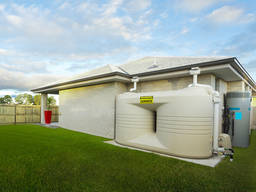Rain Water Tanks

Each Australian on average uses 53,000 liters of water per year. That sounds like a lot but we probably don’t stop to think about the many ways we use water and how the consumption can add up. Not only do we drink water and bathe in it, but we use water to wash our dishes, rinse our fruit and vegetables, wash our clothes (a top loading washing machine can use up to twice the amount of water as a front loader), clean the house, water the garden, wash our cars, hose down our garden paths, driveways and hard surfaces, we top up our swimming pools or wash our pets, the list goes on.
Rain harvesting is a fast growing idea that became mandatory in some areas of Australia due to water shortages. Government and local council rules and regulations vary from state to state and also vary within each state. In some areas where there is a new home build or major renovation being undertaken it is mandatory to install a rain water tank. Therefore it is important to check the regulations in your area with your local council. You may even be eligible for a water tank rebate. Some councils may stipulate that your water tank does not impact on the mains supply or your neighbours water pressure. Even if it’s not mandatory in your area, a rain water tank is a great way to harvest chemical free water that costs you nothing.
Rain water tanks are made of a variety of products including polyethylene, concrete and Colorbond steel. There is quite a lot of choice in sizes, shapes, materials and colours on the market. A supplier will advise you on the best choice and size for your property and budget, taking into account your average rain fall, the size of your roof and the purpose of the tank. For example you may want it just for your garden, or just for the toilet and laundry or as the primary source of your household water. The access for delivery and the position of the tank in relation to collection from your roof and guttering will also be taken into account. Tanks can be installed underground or under decks which is a smart use of space. If you have a narrow space at the side of your home with limited access there are companies that will custom design, engineer and build your tank. The measurements of height, depth and length are calculated to allow installation between windows, external doors, external walls and boundary fencing.
Rain harvesting is a fast growing idea that became mandatory in some areas of Australia due to water shortages. Government and local council rules and regulations vary from state to state and also vary within each state. In some areas where there is a new home build or major renovation being undertaken it is mandatory to install a rain water tank. Therefore it is important to check the regulations in your area with your local council. You may even be eligible for a water tank rebate. Some councils may stipulate that your water tank does not impact on the mains supply or your neighbours water pressure. Even if it’s not mandatory in your area, a rain water tank is a great way to harvest chemical free water that costs you nothing.
Rain water tanks are made of a variety of products including polyethylene, concrete and Colorbond steel. There is quite a lot of choice in sizes, shapes, materials and colours on the market. A supplier will advise you on the best choice and size for your property and budget, taking into account your average rain fall, the size of your roof and the purpose of the tank. For example you may want it just for your garden, or just for the toilet and laundry or as the primary source of your household water. The access for delivery and the position of the tank in relation to collection from your roof and guttering will also be taken into account. Tanks can be installed underground or under decks which is a smart use of space. If you have a narrow space at the side of your home with limited access there are companies that will custom design, engineer and build your tank. The measurements of height, depth and length are calculated to allow installation between windows, external doors, external walls and boundary fencing.
A more recent and very clever rain water tank idea has emerged on the market and is a great space saver for any garden type and particularly for existing homes. Solid fences and retaining walls are built around the tank creating a disguise while saving on space. A planter box can then be positioned above the storage tank in the fence or retaining wall giving you a beautiful garden bed and no one would ever guess there is a water tank beneath.
Some things to remember before making your decision. Make sure the tank you choose meets with Australian Standards. There is no fluoride in rain water so if you are using it for drinking water you should seek advice on alternate sources of fluoride. If you live in an industrial area or close to constantly heavy traffic the quality of your stored water could be compromised by airborne pollutants, therefore it may not be suitable for drinking or food preparation. There is a degree of low but necessary maintenance associated with all rain water storage tanks and there should be a mesh cover to prevent debris entering the tank.
To find someone to install your rain water taken, search the HomeImprovement2day directory.
Some things to remember before making your decision. Make sure the tank you choose meets with Australian Standards. There is no fluoride in rain water so if you are using it for drinking water you should seek advice on alternate sources of fluoride. If you live in an industrial area or close to constantly heavy traffic the quality of your stored water could be compromised by airborne pollutants, therefore it may not be suitable for drinking or food preparation. There is a degree of low but necessary maintenance associated with all rain water storage tanks and there should be a mesh cover to prevent debris entering the tank.
To find someone to install your rain water taken, search the HomeImprovement2day directory.
Quick Links
Articles related to your search:

